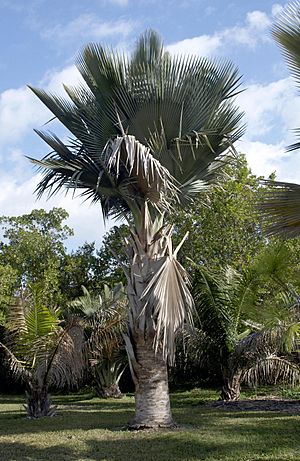Copernicia fallaensis facts for kids
Quick facts for kids Copernicia fallaensis |
|
|---|---|
 |
|
| Scientific classification | |
| Genus: |
Copernicia
|
| Species: |
fallaensis
|
Copernicia fallaensis is a special type of palm tree that grows only in Cuba. This means it is native to Cuba and cannot be found growing naturally anywhere else in the world. It's a unique part of Cuba's natural environment.
Contents
What is Copernicia fallaensis?
Copernicia fallaensis is a member of the Copernicia genus, which includes many beautiful palm trees. These palms are often called "wax palms" because some species have a waxy coating on their leaves. This wax helps the trees survive in dry conditions by reducing water loss.
Where does it grow?
This particular palm tree is found in specific areas of Cuba. Cuba is a large island nation in the Caribbean Sea, known for its warm climate and diverse plant life. The exact locations where Copernicia fallaensis thrives are usually areas with certain soil types and weather patterns that suit its needs perfectly.
What makes it special?
Every plant has unique features, and Copernicia fallaensis is no different. Like many palms, it has a tall, sturdy trunk and large leaves that spread out from the top. These features help it reach sunlight and collect water.
How big does it get?
Copernicia fallaensis can grow quite tall, reaching heights that make it stand out in the landscape. Palm trees grow slowly, adding new leaves and height over many years. Their strong trunks help them withstand tropical winds.
What do its leaves look like?
The leaves of Copernicia fallaensis are large and fan-shaped. They are often stiff and can have a slightly bluish-green color. The way the leaves are arranged helps the tree capture sunlight efficiently for photosynthesis, which is how plants make their own food.
Why are palms important?
Palm trees, including Copernicia fallaensis, are very important for their ecosystems. They provide habitat and food for many animals, from insects to birds. They also help prevent soil erosion and contribute to the beauty of the landscape. For people, palms have been used for centuries for their fruits, wood, and fibers.
See also
 In Spanish: Copernicia fallaensis para niños
In Spanish: Copernicia fallaensis para niños

